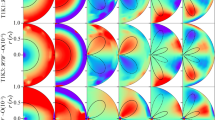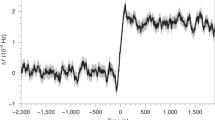Abstract
THE outer layers of neutron stars form a solid crust with a calculable rigidity (shear modulus) very soon after the stars are born. Subsequent changes in stellar shape from oblate toward spherical, as the neutron star angular velocity decreases, will induce stresses in the crust until the maximum shear strain which the solid can support is reached. Beyond this yield point there will be a sudden relaxation of the stress, and a very slight change in stellar shape and moment of inertia. The calculated accompanying jump in angular velocity is close to that which has been observed in a pulsar.
This is a preview of subscription content, access via your institution
Access options
Subscribe to this journal
Receive 51 print issues and online access
$199.00 per year
only $3.90 per issue
Buy this article
- Purchase on Springer Link
- Instant access to full article PDF
Prices may be subject to local taxes which are calculated during checkout
Similar content being viewed by others
References
Ruderman, M., Nature, 218, 1128 (1968).
Clark, C. B., Phys. Rev., 109, 1133 (1958).
Reichley, P., and Downs, G., Nature, 222, 299 (1969).
Radhakrishnan, V., and Manchester, P., Nature, 222, 298 (1969).
Author information
Authors and Affiliations
Rights and permissions
About this article
Cite this article
RUDERMAN, M. Neutron Starquakes and Pulsar Periods. Nature 223, 597–598 (1969). https://doi.org/10.1038/223597b0
Received:
Issue Date:
DOI: https://doi.org/10.1038/223597b0
This article is cited by
-
Searches for continuous-wave gravitational radiation
Living Reviews in Relativity (2023)
-
Pulsar timing irregularities and neutron star interior in the era of SKA: an Indian outlook
Journal of Astrophysics and Astronomy (2022)
-
On the pulsar spin frequency derivatives and the glitch activity
Astrophysics and Space Science (2022)
-
Microglitches in radio pulsars: the role of strange nuggets
Astrophysics and Space Science (2020)
-
Bursts of gravitational waves due to crustquake from pulsars
Journal of Astrophysics and Astronomy (2020)
Comments
By submitting a comment you agree to abide by our Terms and Community Guidelines. If you find something abusive or that does not comply with our terms or guidelines please flag it as inappropriate.



